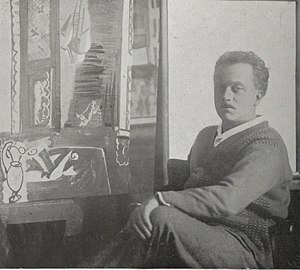Raoul Dufy (1877-1953) was born into a large family at Le Havre, in Normandy. He left school at the age of fourteen to work in a coffee-importing company. In 1895, when Raoul Dufy (1877-1953) was 18, he started taking evening classes in art at Le Havre's École des Beaux-Arts (municipal art school).
Raoul Dufy (1877-1953) was born into a large family at Le Havre, in Normandy. He left school at the age of fourteen to work in a coffee-importing company. In 1895, when Raoul Dufy (1877-1953) was 18, he started taking evening classes in art at Le Havre's École des Beaux-Arts (municipal art school).
In 1900, after a year of military service, Dufy won a scholarship to the École nationale supérieure des Beaux-Arts in Paris, where again he crossed paths with Othon Friesz. (He was there when Georges Braque also was studying.) He concentrated on improving his drawing skills. The impressionist landscape painters, such as Claude Monet and Camille Pissarro, influenced Dufy profoundly. His first exhibition (at the Exhibition of French Artists) took place in 1901. Introduced to Berthe Weill in 1902, Dufy showed his work in her gallery. Then he exhibited again in 1903 at the Salon des Indépendants. A boost to his confidence: the painter, Maurice Denis, bought one of his paintings. Dufy continued to paint, often in the vicinity of Le Havre, and, in particular, on the beach at Sainte-Adresse, made famous by Eugène Boudin and Claude Monet. In 1904, with his friend, Albert Marquet, he worked in Fecamp on the English Channel (La Manche).
Dufy completed one of the largest paintings ever contemplated, a huge and immensely popular ode to electricity, the fresco La Fée Electricité for the 1937 Exposition Internationale in Paris.
Dufy also acquired a reputation as an illustrator and as a commercial artist. He painted murals for public buildings; he also produced a huge number of tapestries and ceramic designs. His plates appear in books by Guillaume Apollinaire, Stéphane Mallarmé, and André Gide.
In 1909, Raoul Dufy was commissioned by Paul Poiret to design stationery for the house, and after 1912[1] designed textile patterns for Bianchini-Ferier used in Poiret's[2] and Charvet's[3] garments.
In the late 1940s and early 1950s, Dufy exhibited at the annual Salon des Tuileries in Paris. By 1950, his hands were struck with rheumatoid arthritis and his ability to paint diminished, as he had to fasten the brush to his hand. In April he went to Boston to undergo an experimental treatment with cortisone and corticotropin, based on the work of Philip S. Hench. It proved successful, and some of his next works were dedicated to the doctors and researchers in the United States.[4][5] In 1952 he received the grand prize for painting in the 26th Venice Biennale. Dufy died at Forcalquier, France, on 23 March 1953, of intestinal bleeding, which was a likely result of his continuous treatment. He was buried near Matisse in the Cimiez Monastery Cemetery in Cimiez, a suburb of the city of Nice.
